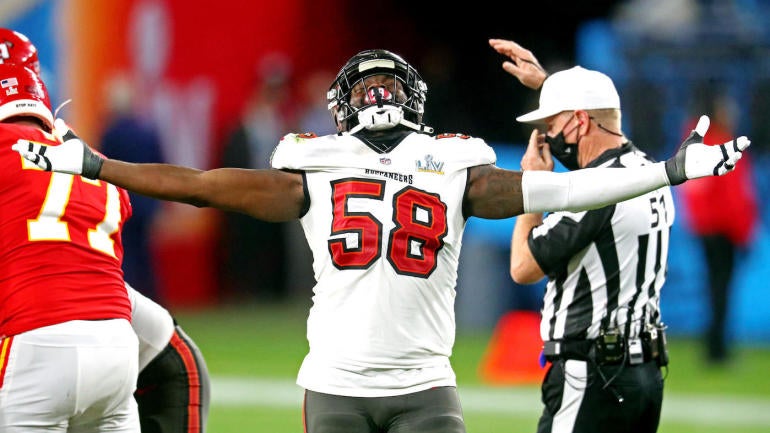
It sounded like wishful thinking when Buccaneers head coach Bruce Arians expressed his desire to "keep the band together" to try to repeat as champions a couple of days after defeating the Chiefs 31-9 in Super Bowl LV. Buccaneers general manager Jason Licht echoed Arians' sentiments about keeping the roster intact, which would require director of football administration Mike Greenberg and director of football of research Jacqueline Davidson to make it possible since managing the salary cap and contract negotiations are their domain. The Buccaneers were scheduled to have 25 unrestricted free agents, including several key offensive and defensive starters, with the salary cap taking a steep drop while having limited cap space.
The NFL and NFLPA initially agreed to a $175 million salary cap floor for 2021 at the end of last July because of league revenues declining due to COVID-19. The 2021 salary cap was ultimately set at $182.5 million, a $15.7 million decrease from the $198.2 million figure in 2020.
The Buccaneers were projected to have approximately $13.1 million of 2021 cap space under offseason accounting rules where only the top 51 salaries (i.e.; cap numbers) matter assuming a $180 million salary cap and after factoring in $4.582 million of cap room carrying over from 2020. The $13.1 million wasn't taking into account $5.82 million of cap space being lost in the reconciliation of not likely to be earned incentives achieved and likely to be earned incentives that weren't attained during the 2020 season.
Craving even more NFL coverage focusing on previews, recaps, news and analysis? Listen below and follow the Pick Six podcast for a daily dose of everything you need to follow pro football.
Franchise tag decision
The first major decision was whether a franchise tag would be placed on wide receiver Chris Godwin or edge rusher Shaquil Barrett would be given the designation for a second straight year. Godwin was kept off the open market with a $15.983 million franchise tag. A second tag on Barrett would have been $20.64 million because the NFL Collective Bargaining Agreement-mandated 20 percent increase would have applied to Barrett's $15.828 million linebacker designation in 2020 and the $1.372 million from the settlement of his grievance to be classified as a defensive end for franchise tag purposes. Retaining Barrett was a priority for the Buccaneers despite the franchise tag decision.
Deviating from the 'pay as you go' contract structure
Linebacker Lavonte David returning was the first sign it wasn't going to be business as usual with the Buccaneers. He agreed to a two-year, $25 million contract with $20 million in guarantees about a week before free agency started.
David's deal was revealing. The Buccaneers uncharacteristically deviated from their preferred "pay as you go" contract structure utilized with practically all veteran signings ever since Mark Dominick's tenure as general manager, which ran from 2009 through 2013. A player's cash and salary cap numbers are the same in each contract year with the "pay as you go" structure because there isn't a signing bonus that's prorated over the life of the contract (for a maximum of five years).
Salary guarantees are given instead under the "pay as you go" model. Deals with this structure have higher cap numbers initially because of the absence of a signing bonus. The first contract year usually consists of a fully guaranteed base salary and a roster bonus due a few days after signing. The second year in the most lucrative "pay as you go" contracts has a fully guaranteed base and roster bonus due during the first couple days of the league year that became fully guaranteed within a few days of initially signing. There may also be conditional guarantees in the third contract year.
A big benefit to "pay as you go" contracts is there aren't any residual salary cap charges or dead money when a player is released during the latter years of the deal once the guarantees have expired, provided the contract hasn't been restructured to create cap room by converting salary into signing bonus.
The "pay as you go" concept isn't embraced by most NFL teams. The Colts and Raiders have been the biggest proponents of this structure besides the Buccaneers.
David's deal includes a roster bonus that was fully guaranteed at signing so it's prorated just like a signing bonus. The Buccaneers went a step further by becoming one of the many NFL teams now using voiding/dummy years in order to prorate bonus money over more years to help combat the $15.7 million drop in the salary cap. Three years voiding on the last day of the 2022 league year in mid-to-late March 2023 were added to David's two-year contract to keep the 2021 cap number small and $11.425 million is being prorated over the five years at $2.285 million annually, making his 2021 cap number $3.36 million since he has a $1.075 million base salary.
Tom Brady contract extension
Making quarterback Tom Brady's $28.375 million 2021 cap number more manageable was a key piece of the puzzle. This meant the "pay as you go" structure used to sign Brady to a fully guaranteed two-year, $50 million deal worth up a maximum of $59 million with incentives in 2020 had to be abandoned.
The five-time Super Bowl MVP freed up $19.3 million of cap space with a one-year, $25 million contract extension running through the 2022 season with three dummy/voiding years (2023 through 2025). Brady's renegotiated contract has a $20 million signing bonus. His fully guaranteed 2021 base salary dropped from $15 million to $1.075 million. The $10 million fifth day of the 2021 league roster bonus from the contract Brady signed in 2020 was replaced with a $20 million fifth day of the 2021 league year roster bonus guaranteed skill, injury and salary cap during the renegotiation. Brady's $20 million signing bonus, of which $15 million is deferred until 2022, and $20 million fully guaranteed roster bonus are prorated over the five years.
The $3.375 million in incentives Brady achieved last season out of a possible $4.5 million were a 2021 cap charge because they were considered likely to be earned. The earned incentives were coupled with an improvement in 2021 from a 2020 offensive team statistic, such as yards per rushing attempt, to be classified as not likely and come off Tampa Bay's 2021 salary cap. A $1,470,588 17th-game roster bonus was included in 2021 and 2022 in case of an additional regular-season game. The subsequent addition of the 17th game raised Brady's 2021 cap number from $9.075 million to $10,545,588.
The rest of the band
The next domino to fall was Barrett. He quickly returned on a four-year, $68 million contract with $34.5 million fully guaranteed (worth a maximum of $72 million through salary escalators). Barrett has $18.75 million of fully guaranteed roster bonuses being prorated over the four years of his deal and the dummy/voiding 2025 contract year that was added. His 2021 cap is $5 million.
Pass rushers were the hottest commodities in free agency. Five other edge rushers besides Barrett (Bud Dupree, Leonard Floyd, Trey Hendrickson, Matthew Judon and Carl Lawson) signed multiyear contracts averaging either at least $15 million per year or with $30 million or more in guarantees. Somewhat surprisingly, none of the edge rushers were able to top the deal Trey Flowers received from the Lions in free agency two years ago. Flowers signed a five-year, $90 million contract containing $56 million in guarantees where $40 million was fully guaranteed at signing.
As expected, tight end Rob Gronkowski, who came out of retirement last year to reunite with Brady, re-signed. He took a one-year deal for $8 million with an additional $2 million in incentives. Four contract years for 2022 through 2025 automatically voiding 23 days before the start of the 2022 league year were added to prorate his fully guaranteed $6.25 million roster bonus over five years. Gronkowski's 2021 cap number is $3 million.
The Buccaneers needed to find another source of cap room, like with Brady's extension, for the signings to continue. Left tackle Donovan Smith, who was entering a contract year, signed a two-year, $31 million extension (running through the 2023 season) with $30 million in guarantees freeing up $10.6 million in cap space. And $13.25 million of Smith's $14.25 million 2021 base salary was converted into a fully guaranteed roster bonus while dummy/voiding 2024 and 2025 contract years were added resulting in $2.65 million of annual bonus proration. Smith's new 2021 cap number is $3.65 million.
The Buccaneers are getting Smith, who turns 28 in June, for a good value at $15.5 million per year. The Colts signed left tackle Anthony Castonzo to a two-year, $33 million contract last March. Castonzo, who is 32, retired following the 2020 season. A few days after Smith's signing, the Raiders gave left tackle Kolton Miller a three-year, $54.15 million extension with $42.5 million in guarantees.
The Smith extension allowed running back Leonard Fournette and defensive tackle Ndamukong Suh to return to the fold. Fournette signed a one-year, $3.25 million contract worth up to $4 million in incentives. He said he turned down bigger contract offers to remain in Tampa. Since voiding/dummy years weren't used with Fournette, his entire $3.25 million salary counts against Tampa Bay's 2021 salary cap.
Suh continued to be a year-to-year proposition by signing a one-year deal for the third straight time with the Buccaneers. His one-year deal is for $9 million with additional $1 million in incentives. As with Gronkowski's contract, four dummy/voiding contract years were added in order to prorate Suh's fully guaranteed $5 million roster bonus over five years. Since Suh's 2021 cap number is $3 million, presumably $2.5 million of Suh's fully guaranteed $4 million base salary was advanced to account for the other $2.5 million being prorated.
An overlooked but important signing was retaining kicker Ryan Succop on a three-year, $12 million contract with $6.25 million in guarantees where there's $750,000 in annual bonus proration. Succop, who made 28 of his 31 field-goal attempts (90.3 percent) last season, was a tremendous bargain in 2020. He played last season under a one-year, $1.05 million veteran salary benefit contract at his league minimum salary, which allowed Tampa Bay to count him on the salary cap at the $750,000 second year player minimum salary. Succop is the rare instance where Tampa Bay didn't using dummy/voiding years with a multiyear contract. His 2021 cap number is $3.5 million.
All 22 starters from the Super Bowl are returning for the Buccaneers, which is unheard of in the salary cap era. The only key contributor from last year's roster who hasn't re-signed is wide receiver Antonio Brown, who made $2 million for half a season after missing the first eight games of 2020 serving a suspension for violating the NFL's Personal Conduct Policy. There's been interest in Brown returning but the two sides reportedly aren't close contractually.
Collectively, Barrett, David, Fournette, Gronkowski, Succop and Suh are taking up $21.1 million of 2021 cap space while making a combined $53.75 million per year. This would not have been possible without Greenberg and Davidson's willingness to be creative and flexible with Tampa Bay's structural contract preferences.
The future is now
The Buccaneers are clearly operating in win-now mode where the short term is a priority over long-range planning. This is often the case when teams feel they have a window of opportunity to win a championship. It's more justifiable for the Buccaneers because they are the reigning Super Bowl champions, ended a 13-year playoff drought last season and Brady, who will be 44 in August, recognizes he doesn't have a lot of football left in his career.
There is a cost to manipulating the salary cap with the dummy/voiding years the Buccaneers and other teams are using so liberally this offseason. In 2022, Tampa Bay is slated to have a combined $11 million in cap charges for Gronkowski and Suh because of the bonus proration in their voiding 2022 through 2025 contract years.
These types of cap charges are scheduled to be much more substantial in 2023. The Buccaneers will have a $24 million cap hit for Brady in 2023 if he decides to retire after the 2022 season when he is 45 years old or his contract isn't extended again before the voiding date, which is the last day of the 2022 league year (March 2023).
David's contract is set to expire at the same time as Brady's with the Buccaneers having a $6.855 million cap charge in 2023 from the bonus proration associated in his 2023 through 2025 contract years also voiding that March. NFL teams seem to be banking on the salary cap beginning to make a huge jump beginning in 2023 because of the new media-rights deals to absorb the cap charges that will be incurred from voiding contract years.





















